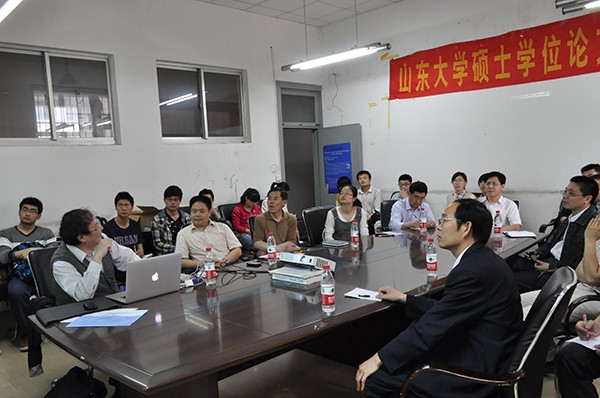On May. 28, a speech named “Bayesian Ying-Yang System, Best Harmony Learning, and Five Action Circling ” was given by Professor Lei Xu from the Chinese University of Hong Kong(CUHK), presided by the deputy dean, Professor Ju Liu of our school. Groups of teachers and students were present, as well.
Firstly, Professor Xu introduced two platforms for academic communication: IScIDE and Journal of Applied Informatics. ISCIDE, functioned as an information interdisciplinary conference, creates profuse chances for prominent engineers and researchers in the field to communicate, and should earn much more active focus and participation in SDU, he said. After the introduction to outstanding contributions from the brightest and the domestic status quo in the field, efforts to establish a "new triangle" were mentioned, one of which is to found the Journal of Applied Informatics. As for this, he encouraged extensive contribution. In his summary, he noted that the leadership of China in research is obvious to all, and everyone at SDU was well advised to be part of it.
Later, the emphasis was put on the Bayesian Ying-Yang System, Best Harmony Learning, and Five Action Circling. Proposed in 1995 and systematically developed in nearly two decades, Bayesian Ying-Yang (BYY) learning is a statistical approach for an intelligent system via two complementary Bayesian representations of a joint distribution on the external observation X and its inner representation R, called BYY system. A Ying-Yang best harmony principle was proposed for learning all the unknowns in the system, with help of an implementation featured by a five action circling. BYY learning provides not only a general framework that accommodates typical learning approaches from a unified perspective but also a road that leads to improved model selection criteria and automatic model selection embedded learning. Thus, this theory can be applied on clustering analyses, image segmentation, speech recognition, HRRP-based target recognition, and tasks of gene analyses.
During the lecture, interactions with students and teachers facilitated comprehension among the audience. The last session being the Q&A part, Professor Xu answered every question with patience and scientific accuracy. The meeting went on at a congenial tempo, and ended in showers of applause. According to spot coverage, the report is of great significance for postgraduate courses.
Lei Xu, chair professor of Chinese Univ Hong Kong (CUHK), Fellow of IEEE (2001-), IAPR Fellow (2002-), and Academician of European Academy of Sciences (2002-). He completed his Ph.D thesis at Tsinghua Univ by the end of 1986, became postdoc at Peking Univ in 1987, then promoted to associate professor in 1988 and a professor in 1992. During 1989-93 he was research associate and postdoc in Finland, Canada and USA, including Harvard and MIT. He joined CUHK as senior lecturer in 1993, professor in 1996, and chair professor in 2002. He has published about 100 journal papers, with a number of well-cited papers on neural networks, statistical learning, and pattern recognition, e.g., his papers got over 4000 citations according to SCI and over 9000 citations according to Google Scholar (GS), with the citations of top-10 papers being (SCI: 911, 344, 285, 204, 184, 174, 144, 96, 96, 85) and (GS: 1949, 744, 587, 511, 467, 299, 271, 209, 202, 191). Prof. Xu served a governor of international neural network society (INNS), a past president of APNNA, and a member of Fellow committee of IEEE Computational Intelligence Society. He is the founding editor-in-chief of Springer open access Journal Applied Informatics, and also serves or served as an associate editor for eight academic journals. Prof. Xu has received several national and international academic awards (e.g., 1993 National Nature Science Award, 1995 INNS Leadership Award and 2006 APNNA Outstanding Achievement Award).

